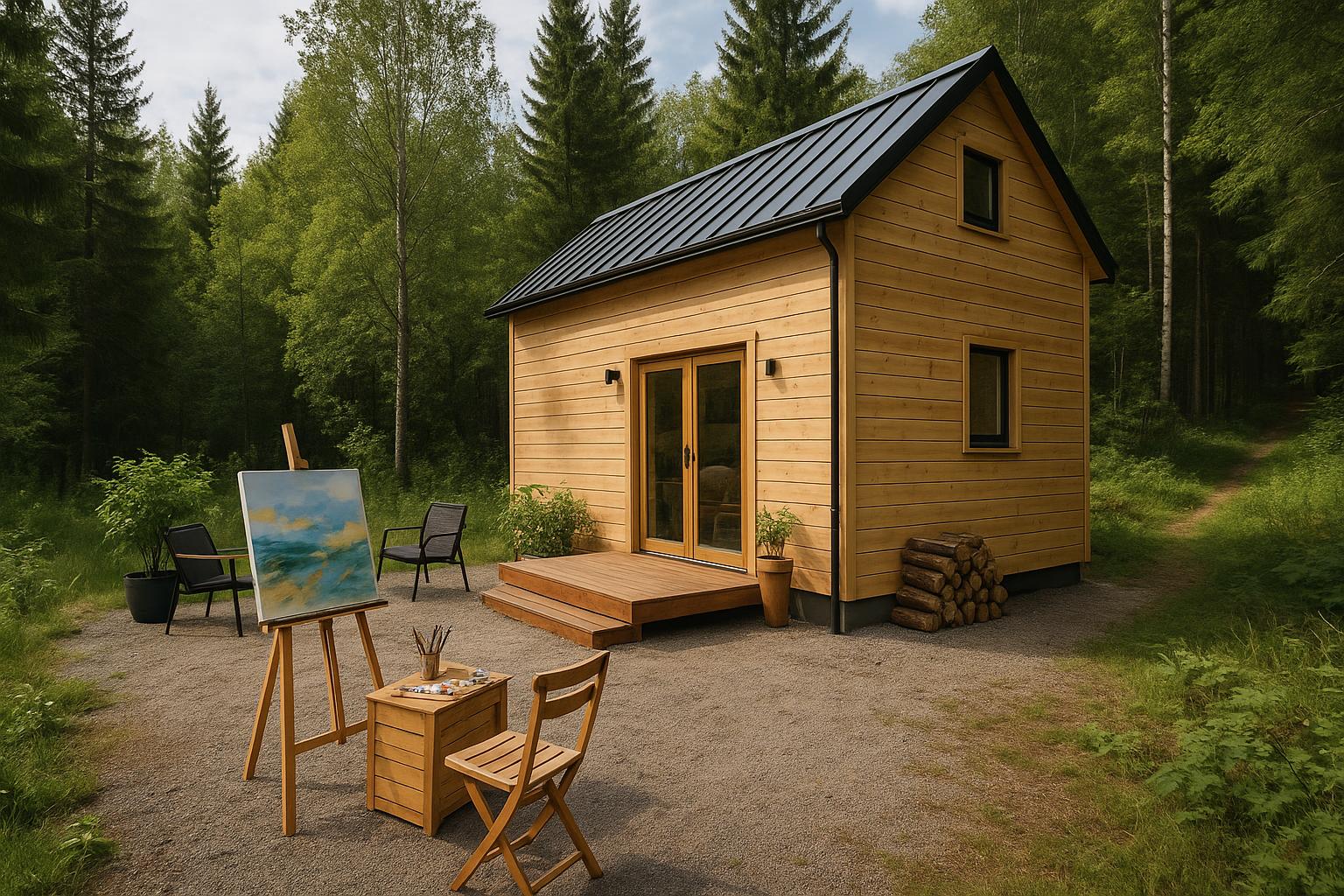
Artist Retreat Tiny Homes: Inspiring Creative Solitude for Canadian Artists
Estimated reading time: 7 minutes
Key Takeaways
- Artist retreat tiny homes are transforming creative spaces for Canadian artists.
- Tiny home studios offer distraction-free environments that blend solitude with inspiration.
- Creative ADU design maximizes small spaces with innovative layouts and sustainable materials.
- Efficient planning and understanding of zoning, permits, and budgets are essential for success.
Table of Contents
- Introduction: Transforming Small Spaces into Creative Havens
- Understanding the Appeal of Artist Retreat Tiny Homes
- Key Features of a Successful Tiny Home Studio for Artists
- Creative ADU Design Ideas for Artist Retreats
- Small Space Inspiration: Tips for Maximizing Limited Square Footage
- Spotlight on Canadian Artists Using Tiny Home Studios
- Practical Considerations for Creating an Artist Retreat Tiny Home
- Conclusion: Embracing the Future of Creative ADU Design
- Frequently Asked Questions
Introduction: Transforming Small Spaces into Creative Havens
Artist retreat tiny homes are redefining the way Canadian artists approach artistic solitude and creative productivity. These purpose-built tiny home studios offer compact yet inspiring spaces, tailored for focused work and imaginative exploration.
Traditionally, creative professionals sought inspiration through remote artist residencies or studio rentals far from home. Now, a growing wave of Canadian artists is turning to ultra-efficient backyard studios and ADUs (Accessory Dwelling Units) to carve out dedicated, distraction-free havens on their own properties. This unique blend of a tiny home studio with practical design and a connection to nature fosters both privacy and inspiration.
Learn more at Canadian Art Junkie.
Understanding the Appeal of Artist Retreat Tiny Homes
The idea of an artist retreat tiny home conjures feelings of peace, focus, and endless creative possibility. But what makes these compact studios so effective?
Why Canadian Artists Are Choosing Tiny Home Studios
- Solitude and Distraction-Free Focus: These standalone spaces replicate the artist residency atmosphere by isolating creative work from daily distractions. This unique setup allows artists to truly lose themselves in their craft. Explore advantages at The Artists’ House and ArtsLinkNB.
- Enhanced Creativity in Small Spaces: A tiny home studio forces intentional organization by limiting materials to essentials. This minimalism channels creative energy, aiding in deep work and experimentation. Read more at Canadian Art Junkie.
- Supporting a Minimalist, Artistic Lifestyle: Incorporating creative ADU design principles, these studios help artists focus on what truly matters, creating a bespoke retreat for inspiration and rejuvenation.
Further resources include:
The Artists’ House
ArtsLinkNB
Key Features of a Successful Tiny Home Studio for Artists
Layout & Space Optimization: Tiny Home Studio and Small Space Inspiration
Designing an effective tiny home studio starts with a clever layout. Even modest footprints can feel spacious with the right approach:
- Maximize Natural Light: Incorporate skylights or large, strategically placed windows to enhance mood and create an illusion of space.
- Open Floor Plans: Avoid unnecessary walls to maintain an open area for easels, tables, or sculpting stands.
- Smart Furniture Placement: Arrange work tables near natural light sources and utilize wall space for storage with foldaway tables and movable seating.
- Vertical Solutions: Use tall storage, shelving, and hooks to free up precious floor area.
Discover more at Akimbo Woodhaven Residency.
Functional Tiny Home Studio Design
- Durable, Cleanable Surfaces: Opt for scratch-resistant counters and floors that can handle the demands of artistic work.
- Adaptability for Multiple Art Forms: Incorporate adjustable workbenches to cater to painters, sculptors, writers, and digital artists alike.
- Soundproofing: Integrate acoustic panels, heavy drapes, and insulated walls to minimize external noises.
- Integrated Storage: Utilize built-in shelves, tool racks, and deep drawers for seamless organization.
Connection to Nature: Artist Retreat Tiny Homes for Canadian Artists
- Design Oriented to Views and Gardens: Strategically placed windows frame inspiring outdoor scenes, be it gardens, forests, or water views.
- Indoor/Outdoor Flow: Incorporate French doors or decks for a fluid transition between work and nature.
- Natural Lighting & Environmental Aesthetics: Enhance the ambiance with live plants, natural fibres, and calming tones to foster tranquility.
Explore more inspiration at ArtsLinkNB Residency by the Sea.
Creative ADU Design Ideas for Artist Retreats
Sustainable and Innovative Building Materials: Creative ADU Design
For Canada’s climate, choosing the right materials is crucial. Sustainable creative ADU design offers both longevity and a reduced environmental footprint:
- Reclaimed Wood: Salvaged boards offer unique textures and an authentic look. Learn more at Reclaimed Materials: The Eco-Friendly and Budget-Friendly Guide.
- Energy-Efficient Insulation: Utilize plant-based or recycled insulation to maintain comfortable temperatures year-round.
- Eco-Friendly Paints and Finishes: Choose low-VOC paints to ensure indoor air quality remains high.
- Durable Roofing and Windows: Invest in high-performance windows and roofing materials to lower maintenance over time.
Multi-Purpose Furniture and Storage Solutions: Small Space Inspiration and Tiny Home Studio
- Modular Shelving: Use adjustable shelves to accommodate evolving artistic needs.
- Fold-Away Furniture: Incorporate tables and beds that can be stowed away to maximize space.
- Lofted Beds and Storage Units: Increase floor usability by elevating beds or storage units.
Inspirational Aesthetics: Personality for Canadian Artists
- Glass Features: Use glass doors and transoms to harvest sunlight, especially valuable during Canadian winters.
- Green Roofs: Benefit from improved insulation and visual integration with natural surroundings. More details at Green Roofs for Tiny Homes.
- Pop-Up Gallery Walls: Install movable panels for displaying art and hosting micro-exhibitions.
- Custom Floor Plans: Tailor every nook to suit your personal workflow, whether enjoying a garden view or a secluded corner.
Learn more through examples at Canadian Art Junkie.
Small Space Inspiration: Tips for Maximizing Limited Square Footage
Effective use of limited space is essential for every artist retreat tiny home. Even the smallest studios can produce big productivity gains with thoughtful organization.
Decluttering and Efficient Storage: Small Space Inspiration
- Vertical Shelving: Utilize tall shelving units to store art supplies while keeping floor space open.
- Magnetic Storage: Install magnetic strips to conveniently hold metal tools and accessories.
- Clearly Labelled Containers: Use transparent bins with labels to simplify organization and maintenance.
Discover additional ideas at Canadian Art Junkie.
Designing Functional Work Zones: Tiny Home Studio
- Creative Partitions: Employ movable dividers or curtains to differentiate work areas.
- Multi-Use Areas: Use rolling tables and stackable stools to adapt spaces for varied creative needs.
Lighting Techniques: Tiny Home Studio and Small Space Inspiration
- Layered Lighting: Combine skylights, large windows, and adjustable task lamps for balanced illumination.
- Adjustable Fixtures: Use swivel-arm lamps to direct light exactly where it is needed.
- Inviting Atmosphere: Soft, warm lighting in relaxation areas promotes reflection between creative sessions.
Research further lighting techniques at Akimbo Woodhaven Residency and find expert tips at Tiny Home Design in Canada.
Spotlight on Canadian Artists Using Tiny Home Studios
Case Studies & Success Stories: Canadian Artists
The Artists’ House, Rural Ontario
Nestled in the Ontario countryside, The Artists’ House offers a compact studio cottage designed for both productivity and comfort. Large windows frame serene natural scenes, and a single-room layout allows seamless transitions between painting, digital work, and quiet reflection. Many artists report enhanced focus and breakthroughs in creative expression.
Learn more at The Artists’ House.
Creative Results in Nova Scotia
The “Introspect: A Residency by the Sea” initiative in St. Andrews, NB provides artists with standalone tiny studios that boast mesmerizing ocean views and direct immersion in the maritime landscape. Participants consistently highlight solitude and environment as key drivers of their inspiration.
Read first-hand accounts at ArtsLinkNB.
Residency Programs: Artist Retreat Tiny Homes and Tiny Home Studio
- Gibraltar Point (Toronto Island): These self-contained creative retreat cabins offer a balanced environment of openness and privacy, ideal for painters, writers, and musicians.
- Introspect – Residency by the Sea: Located along Canada’s east coast, these minimalist, nature-centric micro-studios provide artists with unparalleled working conditions.
Learn more at
Gibraltar Point Residencies
ArtsLinkNB Introspect Residency
Practical Considerations for Creating an Artist Retreat Tiny Home
Zoning, Permits, and Regulations in Canada: Tiny Home Studio for Canadian Artists
- Consult Municipality Regulations: Check local zoning laws, as regulations vary widely and can impact ADU construction. For a detailed guide, visit Canadian ADU Regulations: A Comprehensive Provincial Guide.
- Required Permits: Secure all necessary building, electrical, and plumbing permits before commencing construction.
- Multi-Use & Business Considerations: If the space is intended for commercial use, verify local ordinances regarding home business allowances.
Budgeting & Cost Analysis
Building a tiny home studio is often more affordable than traditional extensions. Consider the following breakdown:
- DIY Studio Kits: Approximately $20,000–$30,000 CAD for basic, uninsulated prefab units.
- Mid-Range Builds: Typically $30,000–$45,000 CAD for insulated, finished spaces with essential utilities.
- High-End Custom Builds: $50,000–$60,000+ CAD for multi-room designs with advanced features like green roofs.
- Operating Costs: Lower than main house utilities, especially with eco-friendly solutions such as solar panels or composting toilets. More information on Composting Toilets.
Funding opportunities exist through grants, arts council support, and community partnerships. Additional details can be found at Canadian Art Junkie.
Conclusion: Embracing the Future of Creative ADU Design
Artist retreat tiny homes offer Canadian artists a unique blend of creative solitude and efficient, inspiring workspaces. With innovative creative ADU design, sustainable materials, and smart layouts, these studios redefine what is possible in small spaces.
Now is the perfect time to reimagine your creative environment with innovative design, minimalist aesthetics, and nature-inspired layouts. Embrace the design revolution and transform even the smallest lot into a powerful engine of artistic production.
For further inspiration, explore comprehensive guides on tiny home living and creative spaces through resources like Tiny Home Living: Your Complete Guide, Mini Homes: The Ultimate Guide, Home Office Solutions, and more.
Frequently Asked Questions
What is an artist retreat tiny home?
An artist retreat tiny home is a compact, purpose-built studio that offers a dedicated, distraction-free space for creative work, blending innovative design with a connection to nature.
How do I secure the necessary permits and regulations?
Before building, consult your local municipality to understand zoning laws and required permits. Detailed guidelines can be found at resources like Canadian ADU Regulations.
Where can I find more inspiration for tiny home design?
You can explore additional design and layout ideas from sources like Canadian Art Junkie or visit artist residency websites such as ArtsLinkNB.

Leave a Reply